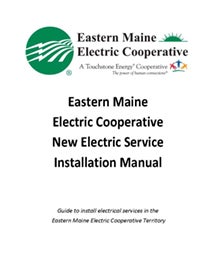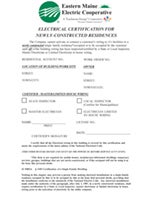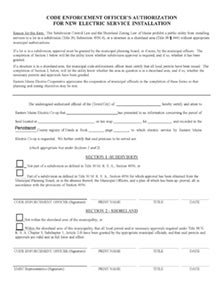
Note: In order to get full functionality from PDF files, the files must be downloaded and opened in Adobe Acrobat Reader. While web browsers will often open PDF files, the Acrobat browser extensions do not provide much functionality.
New Electric Services Installation Manual for Electricians (Download PDF)
A guide for electricians the installation of new electric services in Eastern Maine Electric Cooperative's delivery territory. It is the responsibility of the homeowner to hire properly trained and licensed personnel suited for the task that it is to be completed. This should not be considered a do-it-yourself handbook, and EMEC will not be liable for improper wiring beyond the point of delivery to an individual's premises, equipment, or equipment operation.
Residential Wiring Certificate Form (Download PDF)
Electric utilities cannot connect to a newly constructed residence until it has been certified by a Master Electrician a State Electrical Inspector.
Code Enforcement Officer Authorization for New Service (Download PDF)
In any organized municipality, a code enforcement officer must authorize the utility to connect the new service. In an unorganized territory, a permit is needed from the Land Use Protection Commission (LUPC). If a lot is in a subdivision, approval must be granted by the municipal planning board; or if none, by the municipal officers. The completion of Section 1 below will let the utility know whether subdivision approval is required, and if so, whether it has been granted. (Title 30-A, § 4406.3) If a structure is in a shoreland area, the municipal code enforcement officer must certify that all local permits have been issued. The completion of Section 2, below, will let the utility know whether the area in question is in a shoreland area, and if so, whether the necessary permits and approvals have been granted. (Title 38 § 444)
Tree Trimming and Clearing Right of Way Maintenance Standards (Download PDF)
For electric utilities, “right of way” refers to a specified width of land under and surrounding the power lines and poles. It is the legal path of the lines. The path widths vary from thirty feet to 150 feet depending on the type of overhead line.





